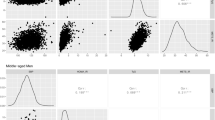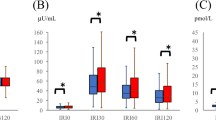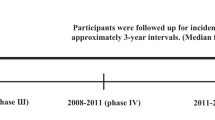Abstract
Elevated pulse pressure (PP) is associated with an increased risk of cardiovascular events. We examined whether PP is associated with post-challenge hyperglycemia in Japanese patients with essential hypertension and impaired glucose tolerance (IGT). In a total of 70 untreated essential hypertensive patients (age: 57±4 years, mean±SD; males±35, females=35), 24-h ambulatory blood pressure (ABP) monitoring, 75 g oral glucose tolerance testing (OGTT), metabolic analysis and echocardiography were performed. Patients were categorized into a high PP group (PP≥60 mmHg, n≥33) or a normal PP group (PP<60 mmHg, n=37). In all patients, 24-h systolic ABP, daytime systolic ABP, nighttime systolic ABP, and nighttime heart rate were significantly higher in the high PP group. Additionally, fasting immunoreactive insulin (F-IRI), homeostasis model assessment (HOMA) index, left ventricular mass index (LVMI) were also elevated in the high PP group. Finally, the high PP group exhibited impaired insulin secretion, increased post-challenge glucose concentrations and greater glucose spikes (PGS) during 75 g OGTT. Of the parameters measured, 24-h PP correlated positively with age, triglyceride, uric acid, F-IRI, HOMA index, 1-h postload glucose and insulin, 2-h postload glucose and insulin, PGS60, PGS120, PGSmax, LVMI, and deceleration time but correlated negatively with HDL-cholesterol and E/A ratio. Multiple regression analysis revealed that PP level was independently predicted by age, LVMI, and PGS120. Our results show that age, LVMI, and PGS120 are significantly associated with high PP in Japanese patients with IGT and essential hypertension.
Similar content being viewed by others
Article PDF
References
Franklin SS, Gustin W 4th, Wong ND, et al: Hemodynamic patterns of age-related changes in blood pressure: the Framingham Heart Study. Circulation 1997; 96: 308–315.
Franklin SS, Khan SA, Wong ND, Larson MG, Levy D : Is pulse pressure useful in predicting coronary heart disease? The Framingham Heart study. Circulation 1999; 100: 354–360.
Benetos A, Safar M, Rudnichi A, et al: Pulse pressure: a predictor of long-term cardiovascular mortality in a French male population. Hypertension 1997; 30: 1410–1415.
Benetos A, Rudnichi A, Safar M, Guize L : Pulse pressure and cardiovascular mortality in normotensive and hypertensive subjects. Hypertension 1998; 32: 560–564.
Fang J, Madhavan S, Alderman MH : Pulse pressure: a predictor of cardiovascular mortality among normotensive subjects. Blood Pressure 2000; 9: 260–266.
Saloman V, Riley W, Kark JD, Nardo C, Folsom AR : Non–insulin-dependent diabetes mellitus and fasting glucose and insulin concentrations are associated with arterial stiffness indexes: the ARIC Study. Circulation 1995; 91: 1432–1443.
Schram MT, Henry RM, van Dijk RA, et al: Increased central artery stiffness in impaired glucose metabolism and type 2 diabetes: the Hoorn Study. Hypertension 2004; 43: 176–181.
van Dijk RAJM, van Ittersum FJ, Westerhof N, et al: Determinants of brachial artery mean 24–h pulse pressure in individuals with type II diabetes mellitus and untreated mild hypertension. Clin Sci 2002; 102: 177–186.
Laakso M : Hyperglycemia and cardiovascular disease in type 2 diabetes. Diabetes 1999; 48: 937–942.
Lee JW, Lee DC, Im JA, Shim JY, Kim SM, Lee HR : Insulin resistance is associated with arterial stiffness independent of obesity in male adolescent. Hypertens Res 2007; 30: 5–11.
Barrett-Connor E, Ferrara A : Isolated postchallenge hyperglycemia and the risk of fatal cardiovascular disease in older women and men. The Rancho Bernardo Study. Diabetes Care 1998; 21: 1236–1239.
DECODE Study Group: Glucose tolerance and cardiovascular mortality: comparison of fasting and 2-hour diagnosis criteria. Arch Intern Med 2001; 161: 397–404.
Tominaga M, Eguchi H, Manaka H, Igarashi K, Kato T, Sekikawa A : Impaired glucose tolerance is a risk fator for cardiovascular disease, but not in impaired fasting glucose. The Funagata Diabetes Study. Diabetes Care 1999; 22: 920–924.
Temelkova-Kurktschiev TS, Koehler C, Leonhardt W, Fuecker K, Hanefeld M : Postchallenge plasma glucose and glycemic spikes are more strongly associated with atherosclerosis than fasting glucose and HbA1c level. Diabetes Care 2000; 23: 1830–1834.
Boyko EJ, Fujimoto WY, Leonetti DL, Newell-Morris L : Visceral adiposity and risk of type 2 diabetes: a prospective study among Japanese Americans. Diabetes Care 2000; 23: 465–471.
Pickering TG, Ad Hoc Panel: Recommendations for the use of home (self) and ambulatory blood pressure monitoring. Am J Hypertens 1996; 9: 1–11.
The Expert Committee on the Diagnosis and Classification of Diabetes Mellitus: Report of the expert committee on the diagnosis and classification of diabetes mellitus. Diabetes Care 1997; 20: 1183–1197.
Tochikubo O, Ikeda A, Miyajima E, Ishii M : Effect of insufficient sleep on blood pressure monitored by a new multibiomedical recorder. Hypertension 1996; 27: 1318–1324.
Kohara K, Nishida W, Maguchi M, Hiwada K : Autonomic nervous function in non-dipper essential hypertensive subjects. Evaluation by power spectral analysis of heart rate variability. Hypertension 1995; 26: 808–814.
Devereux RB, Alonso DR, Lutas EM, et al: Echocardiographic assessment of left ventricular hypertrophy: comparison to necropsy findings. Am J Cardiol 1986; 57: 450–458.
Uen S, Baulmann J, Dusing R, Glanzer K, Vetter H, Mengden T : ST-segment depression in hypertensive patients is linked to elevations in blood pressure, pulse pressure and double product by 24-h Cardiotens monitoring. J Hypertens 2003; 21: 977–983.
Matthews DR, Hosker JP, Rudenski AS, Naylor BA, Treacher DF, Turner RC : Homeostasis model assessment: insulin resistance and beta-cell function from fasting plasma glucose and insulin concentrations in man. Diabetologia 1985; 28: 412–419.
Kanauchi M, Motomiya K, Hashimoto T : Insulin secretion and sensitivity in non-obese and obese Japanese patients with coronary artery disease. Metabolism 2000; 51: 184–188.
Fukushima M, Usami M, Ikeda M, et al: Insulin secretion and insulin sensitivity at different stages of glucose tolerance: a cross-sectional study Japanese type 2 diabetes. Metabolism 2004; 53: 831–835.
Esposito K, Nappo F, Marfella R, et al: Inflammatory cytokine concentrations are acutely increased by hyperglycemia in humans: role of oxidative stress. Circulation 2002; 106: 2067–2072.
Harris TB, Ferrucci L, Tracy RP, et al: Associations of elevated interleukin-6 and C-reactive protein levels with mortality in the elderly. Am J Med 1999; 106: 506–512.
Ceriello A, Bortolotti N, Motz E, et al: Meal-generation oxidative stress in type 2 diabetic patients. Diabetes Care 1998; 21: 1529–1533.
Marfella R, Quagliaro L, Nappo F, Ceriello A, Giugliano D : Acute hyperglycemia induces an oxidant stress in healthy subjects. J Clin Invest 2001; 108: 635–636.
Ceriello A, Bortolotti N, Falleti E, et al: Total radical trapping antioxidant parameter in NIDDM patients. Diabetes Care 1997; 20: 194–197.
Tomiyama H, Kimura Y, Okazaki R, et al: Close relationship of abnormal glucose tolerance with endothelial dysfunction in hypertension. Hypertension 2000; 36: 245–249.
Kawano H, Motoyama T, Hirashima O, et al: Hyperglycemia rapidly suppresses flow-mediated endothelium-dependent vasodilation of brachial artery. J Am Coll Cardiol 1999; 34: 146–154.
Heitzer T, Schling T, Krohn K, Meinertz T, Munzel T : Endothelial dysfunction, oxidative stress, and risk of cardiovascular events in patients with coronary artery disease. Circulation 2001; 104: 2673–2678.
Haenni A, Andersson PE, Lind L, Berne C, Lithell H : Electrolyte changes and metabolic effects of lisinopril/bendrofluazide treatment. Results from a randomized, doubleblind study with parallel groups. Am J Hypertens 1994; 7: 615–622.
Risso A, Mercuri F, Quagliaro L, Damante G, Ceriello A : Intermittent high glucose enhances apoptosis in human umbilical vein endothelial cell in culture. Am J Physiol 2001; 281: E924–E930.
Nakano S, Konishi K, Furuya K, et al: A prognostic role of mean 24-h pulse pressure level for cardiovascular events in type 2 diabetic subjects under 60 years of age. Diabetes Care 2005; 28: 102–107.
Tomiyama H, Yamada J, Koji Y, et al: Heart rate elevation precedes the development of metabolic syndrome in Japanese men: a prospective study. Hypertens Res 2007; 30: 417–426.
Anan F, Takahashi N, Ooie T, Yufu K, Saikawa T, Yoshimatsu H : Role of insulin resistance in nondipper essential hypertensive patients. Hypertens Res 2003; 26: 669–676.
Anan F, Yonemochi H, Masaki T, et al: High-densisty lipoprotein cholesterol and insulin resistance are independently and additive markers of left ventricular hypertrophy in essential hypertension. Hypertens Res 2007; 30: 125–131.
Facchini FS, Stoohs RA, Reaven GM : Enhanced sympathetic nervous system activity. Am J Hypertens 1995; 9: 1013–1017.
Khatter RS, Acharya DU, Kinsey C, Senoir R, Lahiri A : Longitudinal association of ambulatory pulse pressure with left ventricular mass and vascular hypertrophy in essential hypertension. J Hypertens 1997; 15: 737–743.
Jokiniitty JM, Majahalme SK, Kahonen MA, et al: Pulse pressure is the best predictor of future left ventricular mass and change in left ventricular mass: 10 years of follow up. J Hypertens 2001; 19: 2047–2054.
Tarazi RC : The role of the heart in hypertension. Clin Sci 1982; 63: 347S–365S.
Ceravolo R, Maio R, Pujia A, et al; Pulse pressure and endothelial dysfunction in never-treated hypertensive patients. J Am Coll Cardiol 2003; 41: 1753–1758.
Girerd X, Laurent S, Pannier B, Asmar R, Safar M : Arterial distensibility and left ventricular hypertrophy in patients with sustained essential hypertension. Am Heart J 1991; 122: 1210–1214.
Tanaka M, Babazono T, Takeda M, Iwamoto Y : Pulse pressure and chronic kidney disease in patients with type 2 diabtes. Hypertens Res 2006; 29: 345–352.
Takahashi N, Anan F, Nakagawa M, et al: Microalbuminuria, cardiovascular dysfunction, and insulin resistance in patients with type 2 diabetic patients. Metabolism 2004; 53: 1359–1364.
Author information
Authors and Affiliations
Corresponding author
Rights and permissions
About this article
Cite this article
Anan, F., Masaki, T., Eto, T. et al. Postchallenge Plasma Glucose and Glycemic Spikes Are Associated with Pulse Pressure in Patients with Impaired Glucose Tolerance and Essential Hypertension. Hypertens Res 31, 1565–1571 (2008). https://doi.org/10.1291/hypres.31.1565
Received:
Accepted:
Issue date:
DOI: https://doi.org/10.1291/hypres.31.1565
Keywords
This article is cited by
-
Positive association between baseline brachial–ankle pulse wave velocity and the risk of new-onset diabetes in hypertensive patients
Cardiovascular Diabetology (2019)



